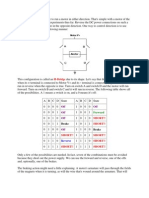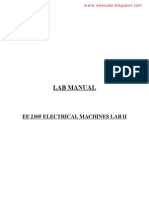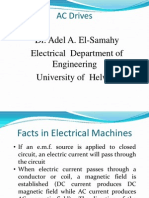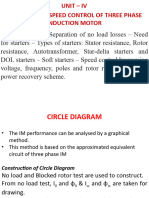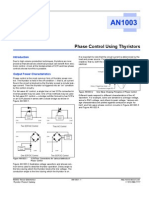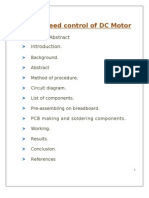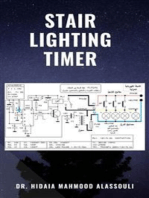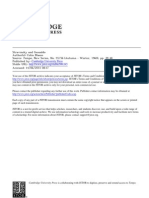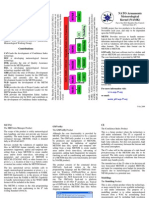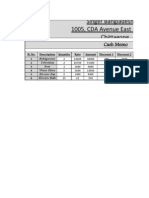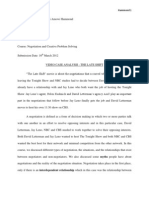Parul Institute of Engineering & Technology
Parul Institute of Engineering & Technology
Uploaded by
rworld999Copyright:
Available Formats
Parul Institute of Engineering & Technology
Parul Institute of Engineering & Technology
Uploaded by
rworld999Original Title
Copyright
Available Formats
Share this document
Did you find this document useful?
Is this content inappropriate?
Copyright:
Available Formats
Parul Institute of Engineering & Technology
Parul Institute of Engineering & Technology
Uploaded by
rworld999Copyright:
Available Formats
Parul Institute Of Engineering
& Technology
Subject Code :- 150906
Name Of Unite :- Electrical Power
Utilization & Traction
Topic :- Electric Drives
Name Of Faculty :- Pratik Patel
Name Of Student:- Rajdeepsinh Chauhan
:- Darshan Desai
Enrollment No. :- 080370119203(09)
:- 080370119205(10)
Electric Drives
Starting Method of D.C. Machine
D.C. Motor
The simplest DC rotating machine consists of a
single loop of wire rotating about a fixed axis. The
magnetic field is supplied by the North and South
poles of the magnet.
Rotor is the rotating : Stator is the stationary part.
We notice that the rotor lies in a slot curved in a
ferromagnetic stator core, which, together with the
rotor core, provides a constant-width air gap
between the rotor and stator.
The reluctance of air is much larger than the
reluctance of core. Therefore, the magnetic flux must
take the shortest path through the air gap.
D.C. Motor Starter
In order for DC motors to function properly, they
must have some special control and protection
equipment associated with them. The purposes
of this equipment are:
To protect the motor against damage due to
short circuits in the equipment;
To protect the motor against damage from long-
term overloads;
To protect the motor against damage from
excessive starting currents;
To provide a convenient manner in which to
control the operating speed of the motor.
D.C. Motor Problems on Starting
At starting conditions, the motor is not turning,
therefore the internal generated voltage EA = 0V.
Since the internal resistance of a normal DC motor is
very low (3-6 % pu), a very high current flows.
For instance, for a 50 hp, 250 V DC motor with
armature resistance RA of 0.06 O and a full-load
current about 200 A, the starting current is
250 0
4167
0.06
T A
A
A
V E
I A
R
= = =
D.C. Motor Problems on Starting
This current is over 20 times the motors rated full-
load current and may severely damage the motor.
A solution to the problem of excessive starting
current is to insert a starting resistor in series with
the armature to limit the current until EA can build
up to limit the armature current. However, this
resistor must be removed from the circuit as the
motor speed is high since otherwise such resistor
would cause losses and would decrease the
motors torque-speed characteristic
In practice, a starting resistor is made up of a series of
resistors that can be successively removed from the
circuit as the motor speeds up.
A shunt motor with an extra starting resistor that can be
cut out of the circuit in segments by closing the 1A,
2A, and 3A contacts.
Therefore, two considerations are needed to be taken
into account:
Select the values and the number of resistor segments
needed to limit the starting current to desired
ranges; Design a control circuit shutting the resistor
bypass contacts at the proper time to remove
particular parts of the resistor from the circuit.
The resistance R
1
must be switched out of the circuit
when the armature current falls to
,1
,min min
350
T A
A
tot
V E
I I A
R
= = =
After the resistance R
1
is out of the circuit, the armature
current must increase to
,2
,max max
,1
700
T A
A
tot
V E
I I A
R
= = =
Since E
A
= K|e, the quantity V
T
E
A
must be constant
when the resistance is switched out. Therefore
min max ,1 tot T A tot
I R V E I R = =
The resistance left in the circuit is
min min
,
max
,1
max
tot t
n
tot n t t o o t
I
R R
I
I
R R
I
=
| |
=
|
\ .
The starting process is completed when R
tot,n
is not
greater than the internal armature resistance R
A
. At the
boundary:
min
,
max
n
A tot n tot
I
R R R
I
| |
= =
|
\ .
Solving for n:
( )
( )
min max
log
log
A tot
R R
n
I I
=
Notice that the number of stages n must be rounded up
to the next integer.
max
250
0.357
700
T
tot
V
R
I
= = = O
( )
( )
( )
( )
min max
log log 0.05 0.357
2.84
log log 350 700
3
A tot
R R
n
I I
= = = ~
b. The armature circuit will contain the armature resistance R
A
and three starting resistors. At first, E
A
= 0, I
A
= 700 A, and the
total resistance is 0.357 O. The total resistance will be in the
circuit until the current drops to 350 A.
,1 ,min
250 350 0.357 125
A T A tot
E V I R V = = =
At this time, the starting resistor R
1
will be taken out
making
,1
,1 2 3
max
250 125
0.1786
700
T A
tot A
V E
R R R R
I
= + + = = = O
This (new) total resistance will be in the circuit until the
current drops again to 350 A. This occurs when
,2 ,min ,1
250 350 0.1786 187.5
A T A tot
E V I R V = = =
At this time, the starting resistor R
2
will be taken out
leaving
,2
,2 3
max
250 187.5
0.0893
700
T A
tot A
V E
R R R
I
= + = = = O
This total resistance will be in the circuit until the current
drops again to 350 A. This occurs when
,3 ,min ,2
250 350 0.0893 218.75
A T A tot
E V I R V = = =
At this time, the starting resistor R
3
will be taken out
leaving only R
A
in the circuit. The motors current at that
moment will increase to
,3
,3
250 218.75
625
0.05
T A
A
A
V E
I A
R
= = =
which is less than the allowed value. Therefore, the
resistances are
3 ,3
2 ,2 3
1 ,1 2 3
0.0893 0.05 0.0393
0.1786 0.0393 0.05 0.0893
0.357 0.1786 0.0393 0.05 0.1786
tot A
tot A
tot A
R R R
R R R R
R R R R R
= = = O
= = = O
= = = O
The resistors R
1
, R
2
, and R
3
are cut out when E
A
reaches
125 V, 187.5 V, and 218.75 V, respectively.
Several different schemes can be used to short contacts and cut out the sections
of a starting resistor. Some devices commonly used in motor-control circuits are
Fuses:
protects
against short
circuits
Spring-type push button switches
Relay: a
main coil
and a
number of
contacts
Time delay
relay similar
to ordinary
relay except
for having
adjustable
time delay.
Overload: a
heater coil
and
normally
closed
contacts
D.C. Motor Starting Circuits
A common DC motor starting circuit:
A series of time delay relays shut contacts
removing each section of the starting resistor at
approximately correct times.
Notice that the relay 1TD is energized at the
same time as the motor starts contacts of 1TD
will shut a part of the starting resistor after
some time. At the same instance, relay 2TD is
energized and so on
Observe also 4 fuses protecting different parts
of the circuit and the overload in series with the
armature winding.
Armature
current in a
DC motor
during
starting.
Another type of motor starter:
A series of relays sense the value of armature
voltage E
A
and cut out the starting resistors as
it riches certain values.
This starter type is more robust to different
loads.
FL is the field loss relay: if the field is lost for
any reason, power to the M relay will be
turned off.
To estimate the efficiency of a DC motor, the following losses must
be determined:
1. Copper losses;
2. Brush drop losses;
3. Mechanical losses;
4. Core losses;
5. Stray losses.
To find the copper losses, we need to know the currents in the
motor and two resistances. In practice, the armature resistance can
be found by blocking the rotor and a small DC voltage to the
armature terminals: such that the armature current will equal to its
rated value. The ratio of the applied voltage to the armature current
is approximately R
A
.
The field resistance is determined by supplying the full-rated field
voltage to the field circuit and measuring the resulting field current.
The field voltage to field current ratio equals to the field resistance.
Brush drop losses are frequently lumped together with copper
losses. If treated separately, brush drop losses are a product of
the brush voltage drop V
BD
and the armature current I
A
.
The core and mechanical losses are usually determined
together. If a motor is running freely at no load and at the
rated speed, the current I
A
is very small and the armature
copper losses are negligible. Therefore, if the field copper
losses are subtracted from the input power of the motor, the
remainder will be the mechanical and core losses. These two
losses are also called the no-load rotational losses. As long as
the motors speed remains approximately the same, the no-
load rotational losses are a good estimate of mechanical and
core losses in the machine under load.
THANK YOU
You might also like
- Load Test On Series GeneratorDocument3 pagesLoad Test On Series Generatorkudupudinagesh88% (8)
- Birth PDFDocument8 pagesBirth PDFspcbanking100% (4)
- Secretary's Certificate - To Open AccountDocument5 pagesSecretary's Certificate - To Open AccountNorhian AlmeronNo ratings yet
- 4.circle Diagram of Three Phase Induction Motor From No Load & Blocked Rotor TestsDocument4 pages4.circle Diagram of Three Phase Induction Motor From No Load & Blocked Rotor Testsmandadi_sailesh67% (3)
- Stabilizing Resistor and MetrosilDocument7 pagesStabilizing Resistor and Metrosilsatya1417100% (1)
- Individual Task: Ayman I. Mohadali BSMT - 1Document5 pagesIndividual Task: Ayman I. Mohadali BSMT - 1Sheima Ainie JuripaeNo ratings yet
- DC Motor Part IIIDocument26 pagesDC Motor Part IIIMohd YasirNo ratings yet
- It Would Be Useful To Be Able To Run A Motor in Either Direction Using H BridgeDocument51 pagesIt Would Be Useful To Be Able To Run A Motor in Either Direction Using H BridgeatulhinduNo ratings yet
- 3-DC Motor StartingDocument10 pages3-DC Motor StartingJohn-Paul Mollineaux0% (1)
- Starter_Circuit_DC_Motor_DesignDocument4 pagesStarter_Circuit_DC_Motor_Designwakeelsahito22No ratings yet
- DC Motor StarterDocument25 pagesDC Motor StarterSrinivasan PrakashNo ratings yet
- Experiment Number 1Document7 pagesExperiment Number 1sakshammahajan24303No ratings yet
- 8 Study of DC Shunt Motor StarterDocument10 pages8 Study of DC Shunt Motor StarterHarshalNo ratings yet
- Busbar Differential Stabllity Test Procedure PDFDocument8 pagesBusbar Differential Stabllity Test Procedure PDFMoinullah Khan Ateeq100% (1)
- Pertanyaan 3 Point StarterDocument21 pagesPertanyaan 3 Point StarterbrianlaksonoNo ratings yet
- DOL, Rotor Resistance and Star To Delta StarterDocument8 pagesDOL, Rotor Resistance and Star To Delta StarterRAMAKRISHNA PRABU GNo ratings yet
- Starting Methods of DC MotorsDocument13 pagesStarting Methods of DC MotorsZealWolfNo ratings yet
- EM-II FinalDocument57 pagesEM-II FinalAtchyut Satya KumarNo ratings yet
- Motor & Thermistor FundaDocument10 pagesMotor & Thermistor Fundajay shahNo ratings yet
- A Voltage Regulated Power SupplyDocument5 pagesA Voltage Regulated Power SupplyCristian OsorioNo ratings yet
- Spa 2Document4 pagesSpa 2millionNo ratings yet
- DC Motors Starters and Breaking MethodsDocument25 pagesDC Motors Starters and Breaking MethodsRukkuArunNo ratings yet
- High Impedence Busbar Protection MetrosilDocument8 pagesHigh Impedence Busbar Protection MetrosilIrfan UllahNo ratings yet
- Brake Load Test of Squirel Cage Induction Motor 3 PhaseDocument7 pagesBrake Load Test of Squirel Cage Induction Motor 3 Phasejassisc100% (1)
- 3-Point Starter NotesDocument5 pages3-Point Starter NotesBobbyNo ratings yet
- DC Motors Starters and Breaking MethodsDocument25 pagesDC Motors Starters and Breaking Methodskrishnareddy_chintalaNo ratings yet
- Exp 10Document9 pagesExp 10Vamsi RamNo ratings yet
- TEE3211 DrivesDocument126 pagesTEE3211 DrivesWebster Fungirai100% (1)
- DC 2 Starter, Brushless, Direct Drive Torque MotorDocument13 pagesDC 2 Starter, Brushless, Direct Drive Torque Motorsunil bangarNo ratings yet
- Capacitor Power Supply CircuitDocument7 pagesCapacitor Power Supply CircuitMISHALSAGARNo ratings yet
- Design of Starters and Their TypesDocument20 pagesDesign of Starters and Their TypesSai Pranahita KulithalaiNo ratings yet
- 1 2-ExpDocument8 pages1 2-Expnyan nyan nyanNo ratings yet
- Starting, Speed Control and Braking of DC Motors: Unit-VDocument32 pagesStarting, Speed Control and Braking of DC Motors: Unit-VPrathap VuyyuruNo ratings yet
- Interview Questions For Eee StudentsDocument11 pagesInterview Questions For Eee StudentsAli ZafarNo ratings yet
- Mahalakshmi: Engineering CollegeDocument21 pagesMahalakshmi: Engineering CollegesenthilkumarNo ratings yet
- Power Systems AssignmentDocument12 pagesPower Systems AssignmentJbmulindwaNo ratings yet
- Bus Bar Diff CalculationDocument8 pagesBus Bar Diff CalculationVinoth MahendranNo ratings yet
- 2 038 PDFDocument11 pages2 038 PDFAmit GauravNo ratings yet
- Edexcel National Certificate/Diploma Unit 67 - Further Electrical Principles NQF Level 3 Outcome 1 Tutorial 3 - Direct Current MotorsDocument11 pagesEdexcel National Certificate/Diploma Unit 67 - Further Electrical Principles NQF Level 3 Outcome 1 Tutorial 3 - Direct Current MotorsRem AremaniaNo ratings yet
- Testingcommissioning Blogspot QaDocument6 pagesTestingcommissioning Blogspot QaratheeshkumardNo ratings yet
- Lab Manual: Ee 2305 Electrical Machines Lab IiDocument38 pagesLab Manual: Ee 2305 Electrical Machines Lab IiskrtamilNo ratings yet
- Induction Motor Notes LVBDocument14 pagesInduction Motor Notes LVBlvb123No ratings yet
- AC Drives: Dr. Adel A. El-Samahy Department of Electrical Engineering University of HelwanDocument25 pagesAC Drives: Dr. Adel A. El-Samahy Department of Electrical Engineering University of Helwanadelelsamahy5958No ratings yet
- Experiment 5Document8 pagesExperiment 5rastgonikoNo ratings yet
- DC Motor StartersDocument5 pagesDC Motor StartersSSNo ratings yet
- PTC1Document5 pagesPTC1jay shahNo ratings yet
- Inductionmotorstarters 230818091729 B317e673Document96 pagesInductionmotorstarters 230818091729 B317e673arunNo ratings yet
- Centre Tapped Transformer SpecificationsDocument4 pagesCentre Tapped Transformer SpecificationsALNATRON GROUPSNo ratings yet
- Thyristor PDFDocument10 pagesThyristor PDFMihir HembramNo ratings yet
- Single PhasingDocument41 pagesSingle PhasingdiljithNo ratings yet
- Induction Motor Equivalent CircuitDocument54 pagesInduction Motor Equivalent CircuitWinston LibangaNo ratings yet
- Automatic Fan Speed ControlDocument11 pagesAutomatic Fan Speed ControlAbhilash Redefining LoveNo ratings yet
- Em Lab-II ManualDocument45 pagesEm Lab-II Manualrkadiraj701160% (5)
- Experiment No-01 AIM: To Perform No Load Test On 3ø Induction MotorDocument17 pagesExperiment No-01 AIM: To Perform No Load Test On 3ø Induction Motornainesh goteNo ratings yet
- Speed Control of DC Motor Using Lm317 Voltage RegulatorDocument18 pagesSpeed Control of DC Motor Using Lm317 Voltage RegulatorSyed muhammad zaidi100% (5)
- DC Motor StartersDocument6 pagesDC Motor StartersAreeb KhanNo ratings yet
- Induction Motor Protection For Single Phasing, Overvoltage and Over TemperatureDocument13 pagesInduction Motor Protection For Single Phasing, Overvoltage and Over Temperatureصدام حسینNo ratings yet
- Electrical Engineering Interview Questions Set-2: What Are The Different Operation Regions of The SCR?Document9 pagesElectrical Engineering Interview Questions Set-2: What Are The Different Operation Regions of The SCR?Uzair AfridiNo ratings yet
- Motor Starter Ac Motor StartersDocument6 pagesMotor Starter Ac Motor StartersShukor Az100% (1)
- Influence of System Parameters Using Fuse Protection of Regenerative DC DrivesFrom EverandInfluence of System Parameters Using Fuse Protection of Regenerative DC DrivesNo ratings yet
- Reference Guide To Useful Electronic Circuits And Circuit Design Techniques - Part 1From EverandReference Guide To Useful Electronic Circuits And Circuit Design Techniques - Part 1Rating: 2.5 out of 5 stars2.5/5 (3)
- Company Profile PT. Berca Hardayaperkasa MSI.R3Document15 pagesCompany Profile PT. Berca Hardayaperkasa MSI.R3Daniel Kristanto SandjojoNo ratings yet
- SQLDocument4 pagesSQLSaumyajitNo ratings yet
- Stravinsky and GesualdoDocument11 pagesStravinsky and GesualdoLuiz Henrique Xavier100% (1)
- Franchise Model Business Plan-SparklemindsDocument8 pagesFranchise Model Business Plan-SparklemindsGopal samyNo ratings yet
- Gopi Botcha: Solutions With Expertise in The ITSMDocument4 pagesGopi Botcha: Solutions With Expertise in The ITSMSai CognosNo ratings yet
- NAMK BrochureDocument2 pagesNAMK BrochureGary NelsonNo ratings yet
- GSM Architecture: Project ReportDocument40 pagesGSM Architecture: Project ReportaadafullNo ratings yet
- Balun Intro and Construction 1Document6 pagesBalun Intro and Construction 1Robson Batista do nascimentoNo ratings yet
- ATI Flash RecoveryDocument3 pagesATI Flash RecoveryUrška KranerNo ratings yet
- What To Say in Thesis DefenseDocument8 pagesWhat To Say in Thesis Defenseafkogftet100% (1)
- ZTE Carrier Aggregation SolutionDocument5 pagesZTE Carrier Aggregation Solutionhasan doganNo ratings yet
- Singer Bangladesh Ltd. 1005, CDA Avenue East Nasirabad, ChittagongDocument34 pagesSinger Bangladesh Ltd. 1005, CDA Avenue East Nasirabad, ChittagongSunny BaruaNo ratings yet
- EEFM PracticeDocument4 pagesEEFM PracticePhoenixRoboNo ratings yet
- EEB601-Superposition Theory Application-2020 PDFDocument5 pagesEEB601-Superposition Theory Application-2020 PDFjoNo ratings yet
- Business Letter NotesDocument7 pagesBusiness Letter NotesYoanneNo ratings yet
- Text of Trump Tweets.Document388 pagesText of Trump Tweets.Jon Meyer100% (3)
- LTE Security Pres 1105 3GPPDocument27 pagesLTE Security Pres 1105 3GPPAbhay1712No ratings yet
- MFJ MFJ-269 Ant Analyser Calibration PDFDocument0 pagesMFJ MFJ-269 Ant Analyser Calibration PDFchaparalNo ratings yet
- Live GuideDocument19 pagesLive GuidebertydoterraNo ratings yet
- Nisa Sukra Putri Resume - NewestDocument1 pageNisa Sukra Putri Resume - NewestThoriq FirstaNo ratings yet
- 58420J Parts ManualDocument63 pages58420J Parts ManualArturo VarelonNo ratings yet
- Computer Science MCQs Practice Test 1 PDFDocument4 pagesComputer Science MCQs Practice Test 1 PDFPriyanka Paul0% (1)
- Letter of IntentDocument2 pagesLetter of IntentRic Napus0% (1)
- SA Spanish CompanyDocument6 pagesSA Spanish CompanysmentorNo ratings yet
- Ductile Iron Castings: Standard Specification ForDocument6 pagesDuctile Iron Castings: Standard Specification ForLuis F. LoachamínNo ratings yet
- Ischak 2017Document8 pagesIschak 2017RochmahAiNurNo ratings yet
- The Late Shift - Analysis - RowieDocument7 pagesThe Late Shift - Analysis - RowieRowie007No ratings yet







